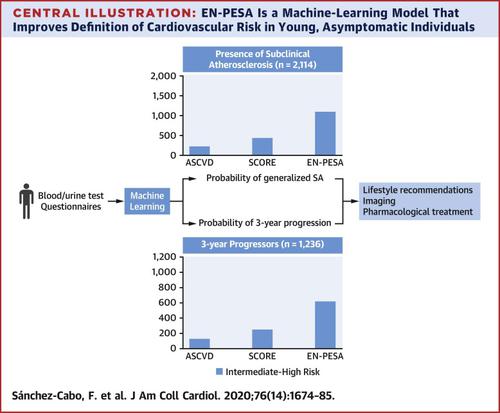当前位置:
X-MOL 学术
›
J. Am. Coll. Cardiol.
›
论文详情
Our official English website, www.x-mol.net, welcomes your feedback! (Note: you will need to create a separate account there.)
Machine Learning Improves Cardiovascular Risk Definition for Young, Asymptomatic Individuals
Journal of the American College of Cardiology ( IF 24.0 ) Pub Date : 2020-10-01 , DOI: 10.1016/j.jacc.2020.08.017 Fátima Sánchez-Cabo , Xavier Rossello , Valentín Fuster , Fernando Benito , Jose Pedro Manzano , Juan Carlos Silla , Juan Miguel Fernández-Alvira , Belén Oliva , Leticia Fernández-Friera , Beatriz López-Melgar , José María Mendiguren , Javier Sanz , Jose María Ordovás , Vicente Andrés , Antonio Fernández-Ortiz , Héctor Bueno , Borja Ibáñez , José Manuel García-Ruiz , Enrique Lara-Pezzi
Journal of the American College of Cardiology ( IF 24.0 ) Pub Date : 2020-10-01 , DOI: 10.1016/j.jacc.2020.08.017 Fátima Sánchez-Cabo , Xavier Rossello , Valentín Fuster , Fernando Benito , Jose Pedro Manzano , Juan Carlos Silla , Juan Miguel Fernández-Alvira , Belén Oliva , Leticia Fernández-Friera , Beatriz López-Melgar , José María Mendiguren , Javier Sanz , Jose María Ordovás , Vicente Andrés , Antonio Fernández-Ortiz , Héctor Bueno , Borja Ibáñez , José Manuel García-Ruiz , Enrique Lara-Pezzi

|
BACKGROUND
Clinical practice guidelines recommend assessment of subclinical atherosclerosis using imaging techniques in individuals with intermediate atherosclerotic cardiovascular risk according to standard risk prediction tools. OBJECTIVES
The purpose of this study was to develop a machine-learning model based on routine, quantitative, and easily measured variables to predict the presence and extent of subclinical atherosclerosis (SA) in young, asymptomatic individuals. The risk of having SA estimated by this model could be used to refine risk estimation and optimize the use of imaging for risk assessment. METHODS
The Elastic Net (EN) model was built to predict SA extent, defined by a combined metric of the coronary artery calcification score and 2-dimensional vascular ultrasound. The performance of the model for the prediction of SA extension and progression was compared with traditional risk scores of cardiovascular disease (CVD). An external independent cohort was used for validation. RESULTS
EN-PESA (Progression of Early Subclinical Atherosclerosis) yielded a c-statistic of 0.88 for the prediction of generalized subclinical atherosclerosis. Moreover, EN-PESA was found to be a predictor of 3-year progression independent of the baseline extension of SA. EN-PESA assigned an intermediate to high cardiovascular risk to 40.1% (n = 1,411) of the PESA individuals, a significantly larger number than atherosclerotic CVD (n = 267) and SCORE (Systematic Coronary Risk Evaluation) (n = 507) risk scores. In total, 86.8% of the individuals with an increased risk based on EN-PESA presented signs of SA at baseline or a significant progression of SA over 3 years. CONCLUSIONS
The EN-PESA model uses age, systolic blood pressure, and 10 commonly used blood/urine tests and dietary intake values to identify young, asymptomatic individuals with an increased risk of CVD based on their extension and progression of SA. These individuals are likely to benefit from imaging tests or pharmacological treatment. (Progression of Early Subclinical Atherosclerosis [PESA]; NCT01410318).
中文翻译:

机器学习改善了年轻、无症状个体的心血管风险定义
背景 临床实践指南建议根据标准风险预测工具,在具有中等动脉粥样硬化心血管风险的个体中使用成像技术评估亚临床动脉粥样硬化。目标 本研究的目的是开发一种基于常规、定量和易于测量的变量的机器学习模型,以预测年轻、无症状个体中亚临床动脉粥样硬化 (SA) 的存在和程度。通过该模型估计 SA 的风险可用于改进风险估计并优化成像用于风险评估的使用。方法 建立弹性网 (EN) 模型以预测 SA 范围,该范围由冠状动脉钙化评分和二维血管超声的组合指标定义。将预测 SA 扩展和进展的模型的性能与心血管疾病 (CVD) 的传统风险评分进行比较。外部独立队列用于验证。结果 EN-PESA(早期亚临床动脉粥样硬化的进展)产生了 0.88 的 c 统计量,用于预测全身性亚临床动脉粥样硬化。此外,发现 EN-PESA 是 3 年进展的预测因子,与 SA 的基线扩展无关。EN-PESA 为 40.1% (n = 1,411) 的 PESA 个体分配了中等至高心血管风险,显着高于动脉粥样硬化 CVD (n = 267) 和 SCORE(系统冠状动脉风险评估)(n = 507)风险评分. 共计 86 个。根据 EN-PESA,8% 的风险增加的个体在基线时出现 SA 迹象或在 3 年内出现明显的 SA 进展。结论 EN-PESA 模型使用年龄、收缩压和 10 种常用的血液/尿液测试和饮食摄入量值,根据 SA 的扩展和进展来识别 CVD 风险增加的年轻、无症状个体。这些人可能会受益于影像学检查或药物治疗。(早期亚临床动脉粥样硬化 [PESA] 的进展;NCT01410318)。这些人可能会受益于影像学检查或药物治疗。(早期亚临床动脉粥样硬化 [PESA] 的进展;NCT01410318)。这些人可能会受益于影像学检查或药物治疗。(早期亚临床动脉粥样硬化 [PESA] 的进展;NCT01410318)。
更新日期:2020-10-01
中文翻译:

机器学习改善了年轻、无症状个体的心血管风险定义
背景 临床实践指南建议根据标准风险预测工具,在具有中等动脉粥样硬化心血管风险的个体中使用成像技术评估亚临床动脉粥样硬化。目标 本研究的目的是开发一种基于常规、定量和易于测量的变量的机器学习模型,以预测年轻、无症状个体中亚临床动脉粥样硬化 (SA) 的存在和程度。通过该模型估计 SA 的风险可用于改进风险估计并优化成像用于风险评估的使用。方法 建立弹性网 (EN) 模型以预测 SA 范围,该范围由冠状动脉钙化评分和二维血管超声的组合指标定义。将预测 SA 扩展和进展的模型的性能与心血管疾病 (CVD) 的传统风险评分进行比较。外部独立队列用于验证。结果 EN-PESA(早期亚临床动脉粥样硬化的进展)产生了 0.88 的 c 统计量,用于预测全身性亚临床动脉粥样硬化。此外,发现 EN-PESA 是 3 年进展的预测因子,与 SA 的基线扩展无关。EN-PESA 为 40.1% (n = 1,411) 的 PESA 个体分配了中等至高心血管风险,显着高于动脉粥样硬化 CVD (n = 267) 和 SCORE(系统冠状动脉风险评估)(n = 507)风险评分. 共计 86 个。根据 EN-PESA,8% 的风险增加的个体在基线时出现 SA 迹象或在 3 年内出现明显的 SA 进展。结论 EN-PESA 模型使用年龄、收缩压和 10 种常用的血液/尿液测试和饮食摄入量值,根据 SA 的扩展和进展来识别 CVD 风险增加的年轻、无症状个体。这些人可能会受益于影像学检查或药物治疗。(早期亚临床动脉粥样硬化 [PESA] 的进展;NCT01410318)。这些人可能会受益于影像学检查或药物治疗。(早期亚临床动脉粥样硬化 [PESA] 的进展;NCT01410318)。这些人可能会受益于影像学检查或药物治疗。(早期亚临床动脉粥样硬化 [PESA] 的进展;NCT01410318)。



























 京公网安备 11010802027423号
京公网安备 11010802027423号